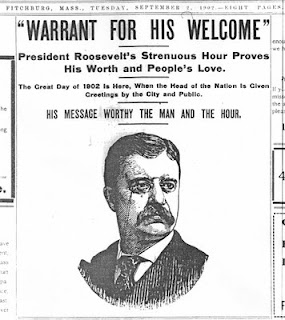Arcadia Publishing puts out wonderful local history books with photographs of bygone eras, famous residents and former hotspots.
After perusing the Fitchburg edition of this series, I zeroed in on a photograph of President Theodore Roosevelt on a train, leaving Fitchburg.
 |
| Fig. 1: Pres. Teddy Roosevelt waves to crowd as he leaves Fitchburg on 09/02/1902. |
"ROOSEVELT'S VISIT. The only president to visit Fitchburg while in office, Theodore Roosevelt made a brief train stop here on September 2, 1902. War veterans escorted him from the station to the Wallace Building, where he gave a speech. In some way, Roosevelt's visit was ironic, as he had succeeded the presidency after the assassination of President McKinley in 1901 by an anarchist who used a revolver manufactured in Fitchburg by Iver Johnson."
I've always been impressed with the myth behind Theodore Roosevelt. Along with Pres. Andrew Jackson, Teddy Roosevelt has morphed into an iconic character resembling masculinity and a larger-than-life figure far removed from his statesman career and political exploits. When I read this caption and saw that he gave a speech, I was determined to track it down and see if I could imagine this bulky "man's man" echoing his bellowing voice throughout Main Street.
 |
| Fig. 2: President Roosevelt and his carriage en route from Union Station to the Wallace Building on Main Street. |
Ten years and ten days after delivering his speech in Fitchburg, Teddy was hot on the campaign trail in Emporia, Kansas discussing the trusts and big bosses' disapproval of the Progressive Party. Though his voice did not match the caricature of the outspoken, nature-warrior, all-around musclebound, monocle-clad superhero we envision today, it pointed me to a different composition of the Roosevelt character. It helped me to remember that Roosevelt was a man, he was a politician, he was a husband, a father and a friend. The mutations of his persona that have enriched the imaginations of youngsters (myself included) like a real-life Superman have their place in the annals of fiction and fantasy. There is a separation between President Theodore Roosevelt and Teddy Roosevelt, and it's here that I was able to witness the former.
After hearing his voice for the first time I wondered how he was received in Fitchburg ten years earlier. It only sounded like Roosevelt was in town very briefly, maybe he passed on through without a sound? I searched through the Sentinel & Enterprise microfilm archives at Fitchburg State and was pleasantly surprised with what I found.
 |
| Fig. 3: Pres. Roosevelt graces the front page of the Fitchburg Daily Sentinel, 09/02/1902 |
 |
| Fig. 4: President Roosevelt delivering his speech in front of the Wallace Building. |
"PRESIDENT ROOSEVELT ADDRESSING THE CITIZENS OF FITCHBURG.
During the President's visit the electric cars were stopped, the side streets were roped off, and a guard of police and specials kept the streets clear of all traffic to prevent the possibility of any accident. It was only two days later in Pittsfield, that the President's coach was run down and wrecked by an electric car. Secret Service Officer Craig instantly killed, and the occupants of the carriage, including the President, Secretary Cortelyou and Governor Crane, narrowly escaped a tragic death."
 |
| Fig. 5: The Wallace Building, home to the Fitchburg Daily Sentinel. The building was razed in 1978. |
No comments:
Post a Comment